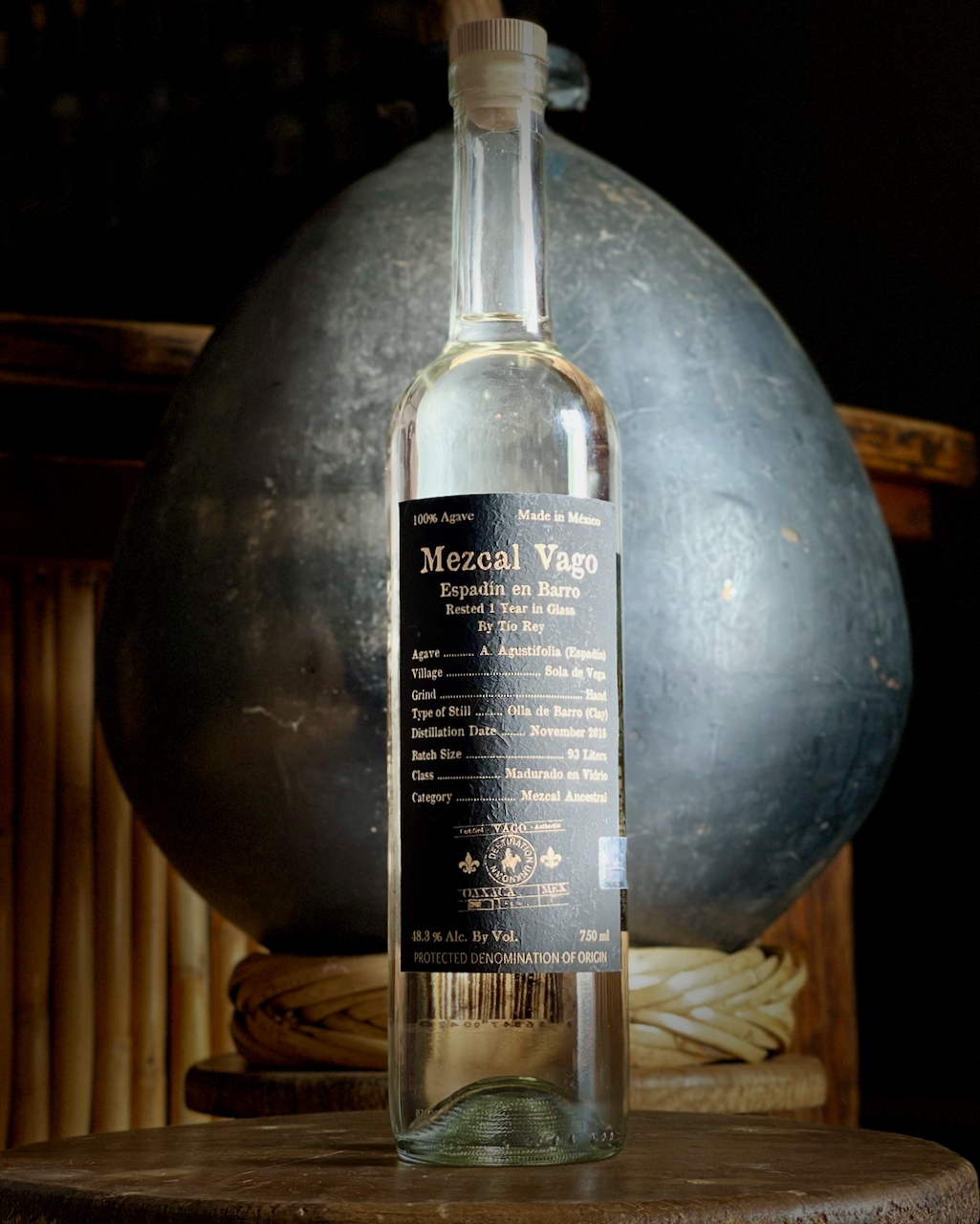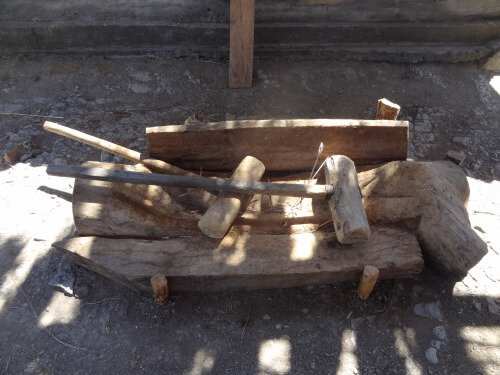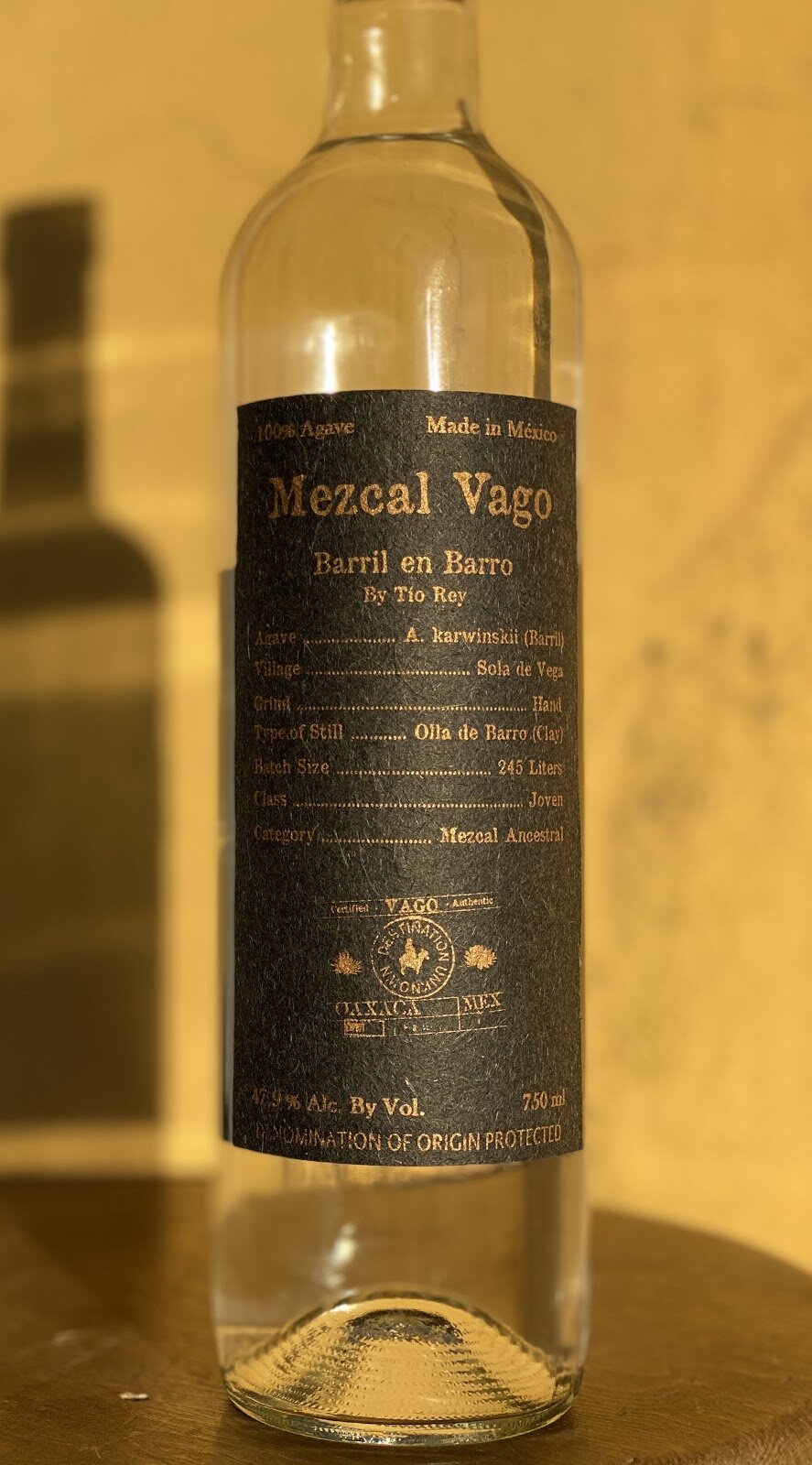Arroqueño en Barro Batch S-05-A-19
For the first time in over two years, Tío Rey has released a batch of pure Arroqueño en Barro. Typically, Tío Rey can only harvest a couple of ripe piñas at a time, he occasionally has enough ripening at the same time to produce a batch of pure Arroqueño. One of the all-time favorites in the Vago lineup, his last batch is still talked about in mezcalerías around the country and traded on internet message boards. While the last batch was limited to less than 92 liters, this new batch is a bit larger, with 85 cases available.
This new batch consisted of 40 piñas, weighing 4,167 kg. They were harvested on March 10, 2019, from the area surrounding Tío Rey’s palenque in Gulerá, Sola de Vega. They were roasted underground for three days between March 12th and March 15th before being milled by hand on March 16th - March 19th. After milling, the batch yielded 4,938 liters of ground agave, to which Tío Rey added 1,073 liters of fresh spring water. The 6,011 liters of tepache fermented for 8 days before being distilled in Tío Rey’s 45-liter clay pot stills, which were handcrafted in Santa Maria Atzompa. The first distillation yielded 565 liters of xixe at 22% ABV, with second distillation yielding 395 liters of mezcal at 47.3% ABV.
Agave Arroqueño (a. Americana var. Oaxacensis)
The Agave Arroqueño is native to the Sola de Vega region and adapts easily from the wild to cultivation. Its Latin name is Agave Americana var.
Oaxacensis. Though Arroqueño shares the same Scientific name as Agave Coyote, they are quite different in both appearance and flavor. Arroqueño take up to 20 years to mature and are identifiable by their larger piña (heart) and narrower penca (leaf). Growing very large, the piñas harvested for this batch were between 100 and 300 kilos each.
These huge, ancient agaves tend to impart flavors that are deep, dark, earthy, and rich. The dank characteristics of Arroqueño are perfectly suited for clay pot distillation. While Tío Rey often uses Agave Arroqueño to balance his Ensamble en Barro mezcals made from several agave types, he loves to make small batches of pure Arroqueño mezcal to showcase it’s awesome characteristics.
According to Howard Scott Gentry, Agave Americana started to appear near what could now be considered the borderlands between the United States and Mexico. They were eventually brought to the central region of Mexico by native peoples that began to cultivate them in the across the Oaxaca valley and into the sierra. Once very prevalent in mezcal production, they began to be pushed out by Agave Angustifolia as mezcaleros began to realize that Espadín has a higher sugar content and matures faster. The current geographic distribution of A. Americana var. Oaxacensis is represented in the map below by the red coloration.
*Image taken from CONABIO website.
Although Espadin has become the standard for mezcal production, being the source of ~90% of all mezcal on the market, a. Americana continues to be utilized, albeit with less frequency. The species has several sub-varieties with sufficient sugars to ferment and then distill. These sub-varieties include, but are not limited to: Arroqueño, Blanco, Cenizo, Coyote, de Castilla, Pulquero, and Sierra Negra.
Producer: Salomón Rey Rodriguez
Location: Sola de Vega, Oaxaca
The palenque and agave fields of Salomón Rey Rodriguez or “Tío Rey” (Uncle Rey) are located in the famous mezcal region Sola de Vega. The mezcaleros in this region distill mezcal almost exclusively using clay pots called “Olla de Barro”.
Tío Rey’s town of Gulerá is about 15 minutes up the valley and is part of the municipality Villas Sola de Vega. The lush mountain valley is a 2.5-hour drive from Oaxaca and sits at 1450 M above sea level.
Tío Rey has a great supply of spring water that flows year round and contributes to the unique flavor of his mezcals. The mineral-rich soil and relatively cooler climate make for a perfect spot for growing a variety of agaves. Salomón Rey has at least 15 varieties of agave that he cultivates, including Espadín, Coyote, Arroqueño, Mexicano, Tobalá, Sierra Negra, Madre Cuixe, Blanco, and Barril.
Sola de Vega agave maturation times:
Espadín - 7 -12 years
Mexicano - 7- 12 years
Arroqueño - 9 - 25 years
Coyote - 5 - 10 years
Sierra Negra 10 -25 Years
Tobalá - 8 - 18 Years
The palenque (distillery) is at Tío Rey’s ranch where he lives full time with his family. He built it approximately 10 years ago from parts of an older palenque that was his fathers. It moved around from nearby locations over the years. The lineage of mezcaleros in Tío Rey’s family could arguably go back thousands of years. They emigrated from the Miahuatlán region over 100 years ago due to Zapatista activity during the Mexican Revolution.
Tío Rey has never produced mezcal commercially before Mezcal Vago and produces exclusively for Mezcal Vago.
Tío Rey’s batch sizes are generally from 100 liters to 450 liters. He has two classic earthen ovens that can each hold around three tons. One oven is the normal dug out hole in the ground and lined with large river rocks and the other is dug straight into bedrock. He roasts each batch for 2 to 3 days.
The cooked agave is hand ground with wooden mallets called canoas y mazos. The roasted piñas are chopped slightly with a machete then the pieces are placed on a wooden platform and pounded with the mallets. An incredibly laborious technique but they are sure the flavor is better this way when not molested by such modern technology as a cement wheel and horse!
Tío Rey has four fermentation vats. Three are typical vats, cylindrical and made from pine. Two have a capacity of 1,200 liters and the third holds 900 liters. The fourth is made from the trunk of a large Pino Sabino (Pine tree) hollowed out in the shape of a canoe and has been in use for 90 years and holds about 900 liters!
For distillation, Tío Rey uses a series of clay pots. The clay pots are called “Olla de Barro” in Spanish. That is why Mezcal Vago refers to its mezcals that are distilled in this manner as “en Barro.” They hold about 45 liters each. Each pair of pots shares a fire. The stills are made of stacks of two pots. One that holds the mash (boiler) and has an open top, and another with an open bottom that rests on top of the first one (condenser). On the top pot there is an upside-down stainless steel bowl that water continually runs in and out of. When the heat from the mash rises and hits the cool top created by the water, condensation occurs. An agave leaf works as a large spoon to catch the dripping condensation (mezcal) and runs into a reed that flows the mezcal into the collection container.
This whole process is laborious and takes around 4 times the effort of a copper still and stone tahona method.
First Distillation
First distillation of a ~45 liter load of tepache takes about 3 - 4 hours and will produce about 8.5 liters of xixe that will have an ABV in the mid-20′s. The next 1.5 hours will produce ~1.5 liters of xixe that does not contain enough flavor to produce mezcal and will be redistilled later for other uses around the palenque.
Rectificación
A ~50 liter batch of xixe will undergo second distillation, or “rectificación” over a period of 5 - 6 hours total. The first 1-2 hours will produce about 2 liters of heads, or “puntas,” which range between ~65-70% ABV. The next 3-4 hours will produce about 15-20 liters of mezcal at a proof of ~40-65% ABV. The final 15 - 20 minutes will produce about ~2-3 liters of tails or “colas” that are roughly 30% ABV. The puntas and colas of the rectificación will be redistilled a third time to be used around the palenque. The containers of usable mezcal will be allowed to rest for a few days before being blended into one single homogeneous batch and then rested in stainless steel or glass. Tío Rey never adds water to his mezcal post-distillation. Cuts are made by taste and smell.
All of Tío Rey’s Mezcal go through a simple triple sediment filtration through tubular cellulose filters. The bottling is done by hand in the city of Oaxaca. The light filtration is the only way the mezcal is affected between how it was made on the palenque and how it ends up in the bottle.
















